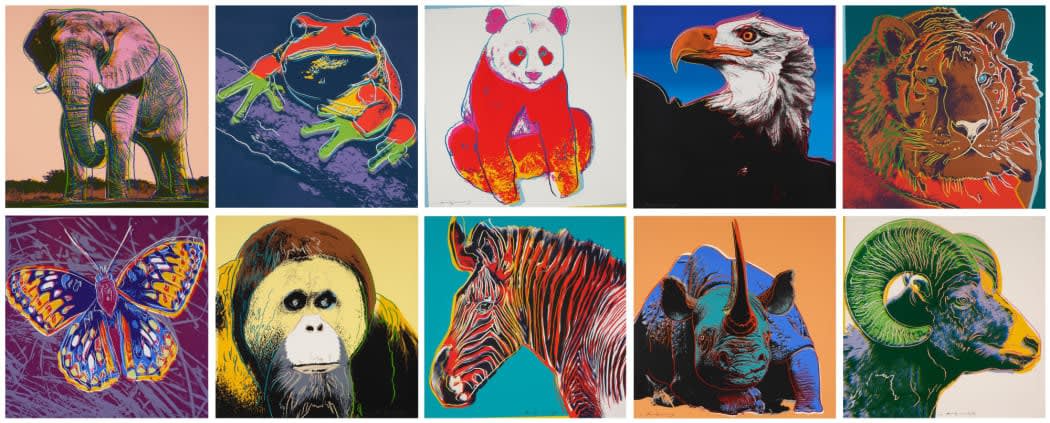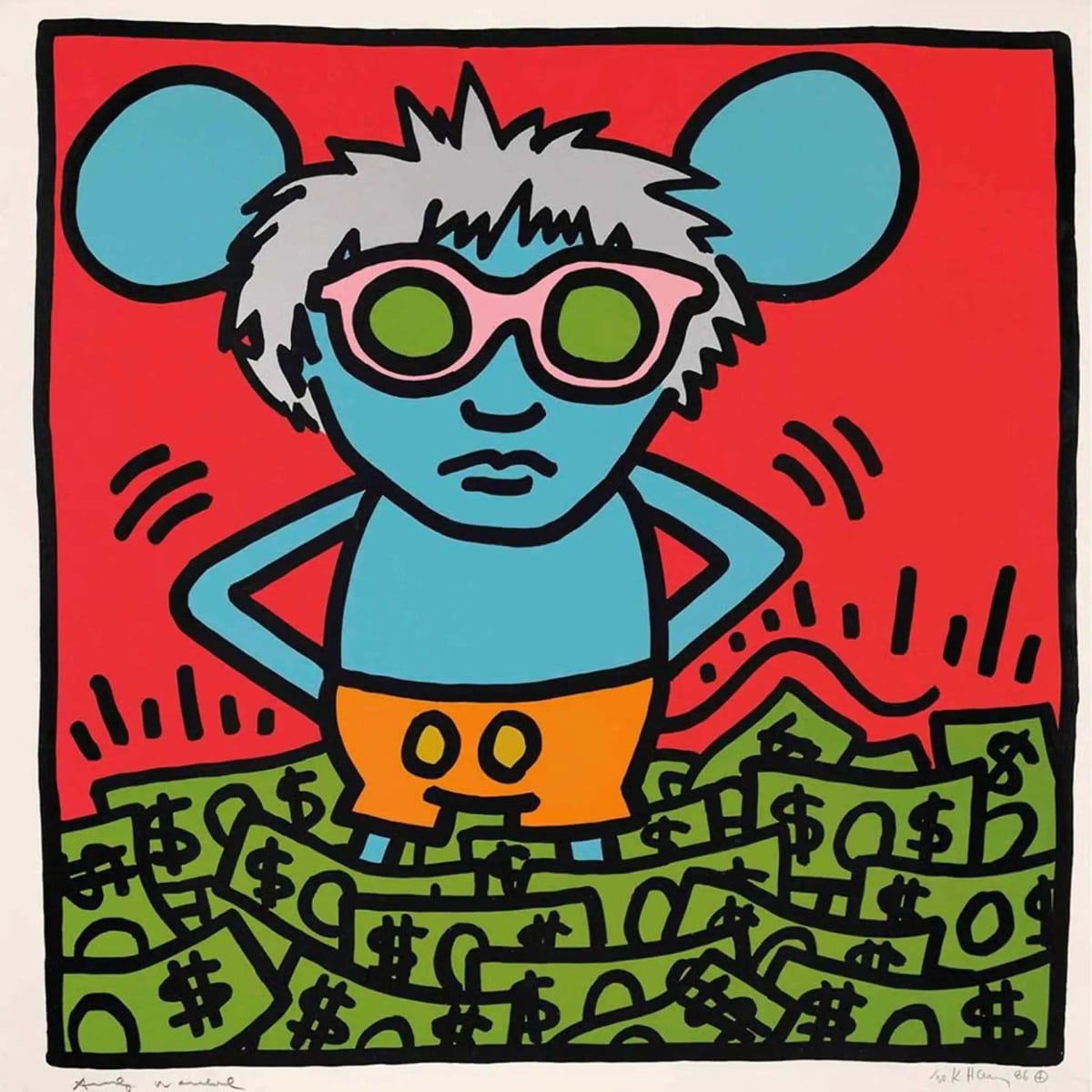
Andy Warhol Endangered Species (F & S. ii 293 - 302)

Created in 1983, the series consists of 10 silkscreen prints featuring images of animals that were endangered or threatened with extinction. The series was a collaboration between Warhol and his friend, the art dealer and gallerist Ron Feldman, and it was created in support of the Endangered Species Act, which was passed by the U.S. Congress in 1973.
The law was designed to protect and conserve endangered and threatened species and their habitats. The Endangered Species Act aims to prevent the extinction of imperilled species and to provide for their recovery by a variety of measures. It has been credited with helping to save many species from extinction, including the bald eagle, the grey wolf, and the American alligator. However, the Act has also been criticised by some for its perceived economic impacts on land use and development. Nevertheless, the ESA remains a cornerstone of wildlife conservation in the United States and has become a model for similar legislation in other countries around the world.
The personal inspiration behind the series was Warhol's concern for the environment and his desire to draw attention to the plight of endangered species. Warhol was known for his interest in mass media and popular culture, and he believed that his art could be used as a tool for social and political commentary. By creating a series of prints featuring endangered animals, Warhol hoped to raise awareness about the importance of conservation and the need to protect endangered species from extinction.

Turtle F & S.II 360
Turtle is a large screenprint published in 1985, wonderfully rendering a sea turtle in pale purple, pink and turquoise. The work was created to coincide with Harold Pinter’s film, Turtle Diary, but can also be recognised as an extension of Warhol’s 1983 portfolio Endangered Species, wherein he portrayed ten endangered animals, calling attention to their preservation. Warhol’s Turtle has an inherent tactile quality: the grains of sand, the wrinkles on the body, and the shell pattern are all shown in fine detail.
Though not endangered like Warhol’s Siberian tigers or African Elephants, the protagonists of Turtle Diary try to rescue turtles from the zoo that are held in captivity. In this late stage of the artist’s career, the artist’s portrayal of animals rather than public figures are a refreshing change and one that challenges the notion of his superficiality.
Banksy - Rats, Elephants and Monkeys

Animals often serve as the vehicle to allow Banksy to explore power dynamics in unusual contexts, often mimicking and reflecting human activities, and allow the artist to challenge the traditional hierarchy and question the existing power structures in society. We have chosen a selection of seminal works that capture Banksy’s sublime use of animal imagery within his oeuvre.
In Banksy's works, rats are anthropomorphized and frequently depicted in humorous scenarios, satirising human imperfections. In his book "Wall and Piece," published in 2006, Banksy references more than 30 different renditions of rats from his early career. When it comes to Banksy's artistic output, he has created numerous murals featuring rats, primarily in England, with a tendency toward smaller-scale pieces. In 2004, Banksy also produced several prints on paper showcasing various iconic rat characters. Surprisingly, considering the significance of rats in his artistic iconography and symbolism,
The rats of Banksy are given great agency and are active. From painting to listening, protesting to running, Banksy imbues his rats with energy and a sense of purpose. In his studio output, the famous series the features rats protesting unofficially titled "The Placard Rats" hold up placards scribbled with the phrases "Welcome to Hell", "Get Out While You Can" and "Because I'm Worthless" phrases that create a sense of menace. Elsewhere, we see "Love Rat" - a phrase commonly given to a cheat - with an artist rat drawing a blook red heart as ink spills across the page. Radar Rat, which also appeared as a street part, can be read as the overarching reach of the state and how we are living in a surveillance state. Finally, the most recent release, Rat Clock which formed part of his GDP pop-up, is a commentary on the rat race that is 21st century life.
Along with rats, other animals Banksy uses include the monkey (Keep it Real and Laugh Now) as well as the elephant which featured in a blindstamp for certain Banksy print editions, the original Pest Control COA and Heavy Weaponry series.
Damien Hirst - Butterflies
Throughout his career, Hirst's use of butterflies has been associated with a range of themes and ideas. At its most basic level, the butterfly represents transformation, growth, and change, and Hirst's works have often explored these themes in depth. The butterfly is a symbol that appears in many cultures and is associated with a range of different meanings and interpretations.
Hirst's earliest works featuring butterflies were his "Butterfly Paintings," which he created in the early 1990s. These works consisted of large, colourful canvases on which Hirst had glued real butterfly wings in intricate patterns. The butterfly wings created a visual effect that was both beautiful and unsettling, as the viewer was confronted with the stark contrast between the bright, vibrant colours of the wings and the dark, sombre background of the canvas. In the mid-1990s, Hirst began incorporating live butterflies into his installations. One of his most famous works from this period was "The Pharmacy," a large-scale installation that recreated a pharmacy complete with shelves of pill bottles and medicine containers. The walls of the pharmacy were lined with tanks containing live butterflies, which flew freely around the space.
Butterflies are the main motif in the seminal series Souls on Jacob’s Ladder and Sanctum.
Keith Haring - Man Mouse

Andy Mouse Portfolio
Andy Mouse is a portfolio of four silkscreen prints created by the artist in 1986. Amongst the most celebrated and famous of Haring’s works, Andy Mouse pays homage to his dear friend, Andy Warhol, and inspiration Walt Disney.
Haring gives cartoon character Mickey Mouse a Pop Art makeover, fusing both Andy Warhol’s physical features, such as his wig, with his instantly-recognisable iconography such as the Dollar Sign. In this way, the portfolio is unequivocally postmodern: ‘It’s treating him (Warhol) like he was part of American Culture, like Mickey Mouse was’. (D. Dreager)
In many ways, Andy Mouse is an intensely personal work. Haring met Warhol in 1982, marking the beginning of a friendship characterised by inspiration and reciprocity. Haring felt deeply indebted to Warhol’s elevation of pop culture to high art: ‘Had Andy (Warhol) not broken the concept of what art is supposed to be, I just wouldn’t be able to exist.’ Meanwhile, Haring introduced Warhol to the latest youth culture. They partied together and collaborated in their artwork (Montreux Jazz Festival, 1986). Importantly to the present portfolio, both artists shared a love of Walt Disney. Having grown up watching cartoons – his father had been an amateur cartoonist, the young Keith Haring aspired to work for the Disney company when he grew up. Taking the obsession to new heights, Warhol said: ‘I said I wanted to be Walt Disney and that if I’d had his machine [xerox machines] ten years ago, I could have made it’. Prescient to the quotation, Haring has granted Warhol’s wish in fashioning the Pop Giant as Disney’s most iconic character.
For more information on any of the artists or artworks featured, contact sales@andipa.com or call +44 (0)20 7589 2371.